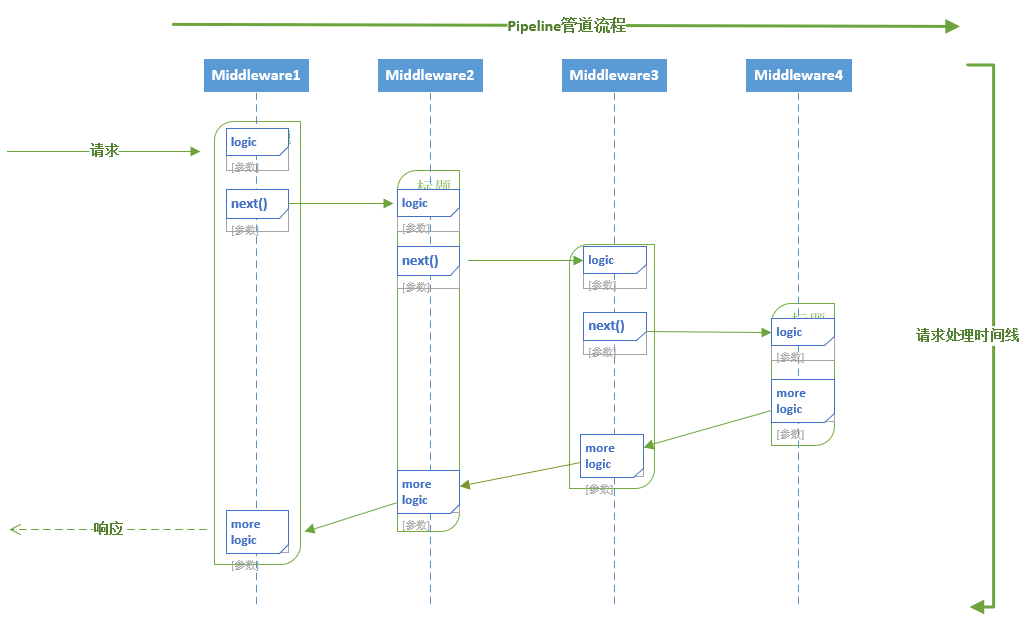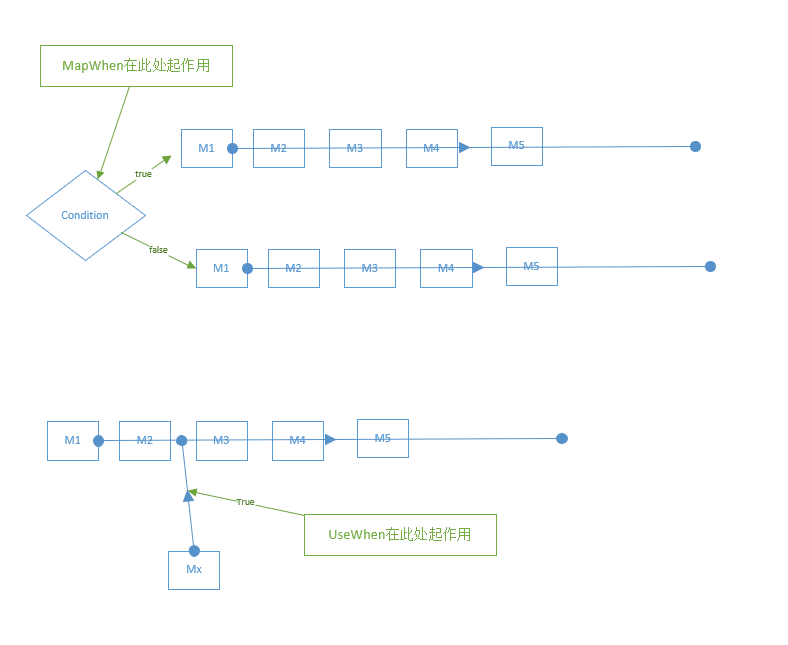ASP.NET Core Middleware 抽丝剥茧
一. 宏观概念
ASP.NET Core Middleware是在应用程序处理管道pipeline中用于处理请求和操作响应的组件。
每个组件是pipeline 中的一环。
自行决定是否将请求传递给下一个组件
在处理管道的下个组件执行之前和之后执行业务逻辑
二. 特性和行为

从上图可以看出,请求自进入处理管道,经历了四个中间件,每个中间件都包含后续紧邻中间件 执行委托(next)的引用,同时每个中间件在交棒之前和交棒之后可以自行决定参与一些Http请求和响应的逻辑处理。
每个中间件还可以决定不将请求转发给下一个委托,这称为请求管道的短路。
短路是有必要的,某些特殊中间件比如 StaticFileMiddleware 可以在完成功能之后,避免请求被转发到其他动态处理过程 。
三. 标准Middleware 使用方式
using System.Threading.Tasks;
using Alyio.AspNetCore.ApiMessages;
using Gridsum.WebDissector.Common;
using Microsoft.AspNetCore.Http;
namespace Gridsum.WebDissector
{
sealed class AuthorizationMiddleware
{
private readonly RequestDelegate _next; // 下一个中间件执行委托的引用
public AuthorizationMiddleware(RequestDelegate next)
{
_next = next;
}
public Task Invoke(HttpContext context) // 贯穿始终的HttpContext对象
{
if (context.Request.Path.Value.StartsWith("/api/"))
{
return _next(context);
}
if (context.User.Identity.IsAuthenticated && context.User().DisallowBrowseWebsite)
{
throw new ForbiddenMessage("You are not allow to browse the website.");
}
return _next(context);
}
}
}
public static IApplicationBuilder UserAuthorization(this IApplicationBuilder app)
{
return app.UseMiddleware<AuthorizationMiddleware>();
}
// 启用该中间件,也就是注册该中间件
app.UserAuthorization();
四. 观察标准中间件的定义方式,带着几个问题探究源码实现
① 中间件传参是怎样完成的: app.UseMiddleware<Authorization>(AuthOption); 我们传参的时候,为什么能自动注入中间件构造函数非第1个参数?
② 编写中间件的时候,为什么必须要定义特定的 Invoke/InvokeAsync 函数?
③ 设定中间件的顺序很重要,中间件的嵌套顺序是怎么确定的 ?
思考标准中间件的行为:
- 输入下一个中间件的执行委托Next;
- 定义当前中间件的执行委托Invoke/InvokeAsync;
每个中间件完成了 Func<RequestDelegate,RequestDelegate>这样的行为;
通过参数next与下一个中间件的执行委托Invoke/InvokeAsync 建立"链式"关系。
public delegate Task RequestDelegate(HttpContext context);
//-----------------节选自 Microsoft.AspNetCore.Builder.UseMiddlewareExtensions------------------
/// <summary>
/// Adds a middleware type to the application's request pipeline.
/// </summary>
/// <typeparam name="TMiddleware">The middleware type.</typeparam>
/// <param name="app">The <see cref="IApplicationBuilder"/> instance.</param>
/// <param name="args">The arguments to pass to the middleware type instance's constructor.</param>
/// <returns>The <see cref="IApplicationBuilder"/> instance.</returns>
public static IApplicationBuilder UseMiddleware<TMiddleware>(this IApplicationBuilder app, params object[] args)
{
return app.UseMiddleware(typeof(TMiddleware), args);
}
/// <summary>
/// Adds a middleware type to the application's request pipeline.
/// </summary>
/// <param name="app">The <see cref="IApplicationBuilder"/> instance.</param>
/// <param name="middleware">The middleware type.</param>
/// <param name="args">The arguments to pass to the middleware type instance's constructor.</param>
/// <returns>The <see cref="IApplicationBuilder"/> instance.</returns>
public static IApplicationBuilder UseMiddleware(this IApplicationBuilder app, Type middleware, params object[] args)
{
if (typeof(IMiddleware).GetTypeInfo().IsAssignableFrom(middleware.GetTypeInfo()))
{
// IMiddleware doesn't support passing args directly since it's
// activated from the container
)
{
throw new NotSupportedException(Resources.FormatException_UseMiddlewareExplicitArgumentsNotSupported(typeof(IMiddleware)));
}
return UseMiddlewareInterface(app, middleware);
}
var applicationServices = app.ApplicationServices;
return app.Use(next =>
{
var methods = middleware.GetMethods(BindingFlags.Instance | BindingFlags.Public); // 执行委托名称被限制为Invoke/InvokeAsync
var invokeMethods = methods.Where(m =>
string.Equals(m.Name, InvokeMethodName, StringComparison.Ordinal)
|| string.Equals(m.Name, InvokeAsyncMethodName, StringComparison.Ordinal)
).ToArray();
)
{
throw new InvalidOperationException(Resources.FormatException_UseMiddleMutlipleInvokes(InvokeMethodName, InvokeAsyncMethodName));
}
)
{
throw new InvalidOperationException(Resources.FormatException_UseMiddlewareNoInvokeMethod(InvokeMethodName, InvokeAsyncMethodName, middleware));
}
];
if (!typeof(Task).IsAssignableFrom(methodInfo.ReturnType))
{
throw new InvalidOperationException(Resources.FormatException_UseMiddlewareNonTaskReturnType(InvokeMethodName, InvokeAsyncMethodName, nameof(Task)));
}
var parameters = methodInfo.GetParameters();
|| parameters[].ParameterType != typeof(HttpContext))
{
throw new InvalidOperationException(Resources.FormatException_UseMiddlewareNoParameters(InvokeMethodName, InvokeAsyncMethodName, nameof(HttpContext)));
}
];
ctorArgs[] = next;
Array.Copy(args, , ctorArgs, , args.Length); // 通过反射形成中间件实例的时候,构造函数第一个参数被指定为 下一个中间件的执行委托 var instance = ActivatorUtilities.CreateInstance(app.ApplicationServices, middleware, ctorArgs);
)
{
return (RequestDelegate)methodInfo.CreateDelegate(typeof(RequestDelegate), instance);
}
// 当前执行委托除了可指定HttpContext参数以外, 还可以注入更多的依赖参数
var factory = Compile<object>(methodInfo, parameters);
return context =>
{
var serviceProvider = context.RequestServices ?? applicationServices;
if (serviceProvider == null)
{
throw new InvalidOperationException(Resources.FormatException_UseMiddlewareIServiceProviderNotAvailable(nameof(IServiceProvider)));
}
return factory(instance, context, serviceProvider);
};
});
}
//-------------------节选自 Microsoft.AspNetCore.Builder.Internal.ApplicationBuilder-------------------
private readonly IList<Func<RequestDelegate, RequestDelegate>> _components = new List<Func<RequestDelegate, RequestDelegate>>();
publicIApplicationBuilder Use(Func<RequestDelegate,RequestDelegate> middleware)
{
this._components.Add(middleware);
return this;
}
public RequestDelegate Build()
{
RequestDelegate app = context =>
{
context.Response.StatusCode = ;
return Task.CompletedTask;
};
foreach (var component in _components.Reverse())
{
app = component(app);
}
return app;}
通过以上代码我们可以看出:
- 注册中间件的过程实际上,是给一个 Type为List<Func<RequestDelegate, RequestDelegate>> 的容器依次添加元素的过程;
- 容器中每个元素对应每个中间件的行为委托Func<RequestDelegate, RequestDelegate>, 这个行为委托包含2个关键行为:输入下一个中间件的执行委托next:RequestDelegate, 完成当前中间件的Invoke函数: RequestDelegate;
通过build方法完成前后中间件的链式传值关系

分析源码:回答上面的问题:
① 使用反射构造中间件的时候,第一个参数Array[0] 是下一个中间件的执行委托
② 当前中间件执行委托 函数名称被限制为: Invoke/InvokeAsync, 函数支持传入除HttpContext之外的参数
③ 按照代码顺序添加进入 _components容器, 通过后一个中间件的执行委托 ------> 前一个中间件的输入执行委托建立链式关系。
附:非标准中间件的用法
短路中间件、 分叉中间件、条件中间件
整个处理管道的形成,存在一些管道分叉或者临时插入中间件的行为,一些重要方法可供使用
Use方法是一个注册中间件的简便写法
Run方法是一个约定,一些中间件使用Run方法来完成管道的结尾
Map扩展方法:请求满足指定路径,将会执行分叉管道,强调满足 path
MapWhen方法:HttpContext满足条件,将会执行分叉管道:
UseWhen方法:HttpContext满足条件 则插入中间件

感谢您的认真阅读,如有问题请大胆斧正,如果您觉得本文对你有用,不妨右下角点个 或加关注。
或加关注。
本文版权归作者所有,欢迎转载,但未经作者同意必须保留此段声明,且在文章页面明显位置注明本文的作者及原文链接,否则保留追究法律责任的权利。
ASP.NET Core Middleware 抽丝剥茧的更多相关文章
- ASP.NET Core Middleware (转载)
What is Middleware? Put simply, you use middleware components to compose the functionality of your A ...
- Prerender Application Level Middleware - ASP.NET Core Middleware
In the previous post Use Prerender to improve AngularJS SEO, I have explained different solutions at ...
- [ASP.NET Core] Middleware
前言 本篇文章介绍ASP.NET Core里,用来处理HTTP封包的Middleware,为自己留个纪录也希望能帮助到有需要的开发人员. ASP.NET Core官网 结构 在ASP.NET Core ...
- ASP.NET Core Middleware管道介绍
public void Configure(IApplicationBuilder app, IHostingEnvironment env) { app.Use(async (context, ne ...
- 翻译 - ASP.NET Core 基本知识 - 中间件(Middleware)
翻译自 https://docs.microsoft.com/en-us/aspnet/core/fundamentals/middleware/?view=aspnetcore-5.0 中间件是集成 ...
- [转]Publishing and Running ASP.NET Core Applications with IIS
本文转自:https://weblog.west-wind.com/posts/2016/Jun/06/Publishing-and-Running-ASPNET-Core-Applications- ...
- 如何一秒钟从头构建一个 ASP.NET Core 中间件
前言 其实地上本没有路,走的人多了,也便成了路. -- 鲁迅 就像上面鲁迅说的那样,其实在我们开发中间件的过程中,微软并没有制定一些策略或者文档来约束你如何编写一个中间件程序, 但是其中却存在者一些最 ...
- 极简版ASP.NET Core学习路径及教程
绝承认这是一个七天速成教程,即使有这个效果,我也不愿意接受这个名字.嗯. 这个路径分为两块: 实践入门 理论延伸 有了ASP.NET以及C#的知识以及项目经验,我们几乎可以不再需要了解任何新的知识就开 ...
- asp.net core中写入自定义中间件
首先要明确什么是中间件?微软官方解释:https://docs.microsoft.com/zh-cn/aspnet/core/fundamentals/middleware/?tabs=aspnet ...
随机推荐
- jQuery学习之旅 Item8 DOM事件操作
1.jquery页面载入事件 1.传统加载事件 <body onload="函数名()"> 页面全部html和css代码加载完成之后再调用指定的onload函数 win ...
- SimpleDateFormat安全的时间格式化
SimpleDateFormat安全的时间格式化 想必大家对SimpleDateFormat并不陌生.SimpleDateFormat 是 Java 中一个非常常用的类,该类用来对日期字符串进行解析和 ...
- VMware workstation的基础使用
1. VMware workstation虚拟化平台简介2. VMware workstation提供网络资源3. VMware workstation提供存储资源4. VMware workstat ...
- ISCC2018(最新的考核解析)
最近一直在做这个 ISCC2018,感觉可能自己只是一个新手吧!但是我会继续努力的,希望我的解题思路能够给你们带来一定的想法,我也希望自己能够在安全方面遇到更多志同道合的人! 其它题目可以看这里 1 ...
- Resnet论文翻译
摘要 越深层次的神经网络越难以训练.我们提供了一个残差学习框架,以减轻对网络的训练,这些网络的深度比以前的要大得多.我们明确地将这些层重新规划为通过参考输入层x,学习残差函数,来代替没有参考的学习函数 ...
- TensorFlow之DNN(一):构建“裸机版”全连接神经网络
博客断更了一周,干啥去了?想做个聊天机器人出来,去看教程了,然后大受打击,哭着回来补TensorFlow和自然语言处理的基础了.本来如意算盘打得挺响,作为一个初学者,直接看项目(不是指MINIST手写 ...
- 你真的了解String吗?(修正版)
修正前:new出来的对象,会在堆中存放真正的值: 大错特错!!!! 修正后:new出来的对象,堆存放的并不是真正的值,而是常量池中字符串常量的地址. 一.抛砖引玉 不知道大家在做面试题时是否会遇到 ...
- Linux、docker、kubernetes、MySql、Shell、kafka、RabbitMQ运维快餐
检查端口占用 lsof -i:[port] netstat -anp |grep [port] 监控网络客户TCP连接数 netstat -anp | grep tcp |wc -l 获取某进程中运行 ...
- .NET Core使用Quartz执行调度任务进阶
一.前言运用场景 Quartz.Net是一个强大.开源.轻量的作业调度框架,在平时的项目开发当中也会时不时的需要运用到定时调度方面的功能,例如每日凌晨需要统计前一天的数据,又或者每月初需要统计上月的数 ...
- java数据结构和算法02(栈)
什么叫做栈(Stack)呢?这里的栈和jvm的java栈可不是一个东西... 栈作为一种数据结构,我感觉栈就类似一种接口,实现的话有很多种,比如用数组.集合.链表都可以实现栈的功能,栈最大的特点就是先 ...
